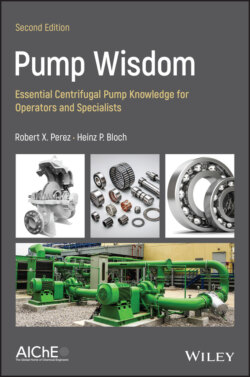Читать книгу Pump Wisdom - Robert X. Perez - Страница 14
Impellers and Rotors
ОглавлениеRegardless of flow classification centrifugal pumps range in size from tiny pumps to very big pumps. The tiny ones might be used in medical or laboratory applications; the extremely large pumps may move many thousands of liters or even gallons per second from flooded lowlands to the open sea.
All six of the impellers in Figure 1.5 are shown with a hub fastening the impeller to the shaft, and each of the first five impellers is shown as a hub‐and‐disc version with an impeller cover. The cover (or “shroud”) identifies the first five as “closed” impellers; recall that Figure 1.3 had depicted a semiopen impeller. Semiopen impellers are designed and fabricated without the cover. Finally, open impellers come with free‐standing vanes welded to or integrally cast into the hub. Since the latter incorporate neither disc nor cover, they are often used in viscous or fibrous paper stock applications.
To properly function, a semiopen impeller must operate in close proximity to a casing internal surface, which is why axial adjustment features are needed with these impellers. Axial location is a bit less critical with closed impellers. Except on axial flow pumps, fluid exits the impeller in the radial direction. Radial and mixed flow pumps are either single or double suction designs; both will be shown later. Once the impellers are fastened to a shaft, the resulting assembly is called a rotor.
In radial and mixed flow pumps, the number of impellers following each other, typically called “stages,” can range from one to as many as will make such multistage pumps practical and economical to manufacture. Horizontal shaft pumps with up to 12 stages are not uncommon; using more than 12 stages on a horizontal shaft risks causing the rotor to resonate or vibrate at a so‐called “critical speed.” Vertical shaft pumps have been designed with 48 or more stages. In vertical pumps, shaft support bushings are relatively lightly loaded; they are spaced so as to minimize vibration risk.
Figure 1.5 General flow classifications of process pump impellers.
